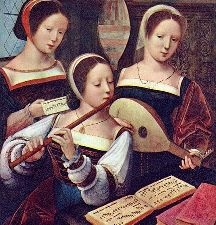Lesson 3: The Music of the Renaissance
Lesson 3: The Music of the Renaissance

Lesson 3: The Music of the Renaissance
The Music of the Renaissance
 In some ways, the music of the early Renaissance was a reaction to the music of the late medieval period. Whereas musical forms like the ars nova were complex, early Renaissance music was often simpler and smoother. The change was a gradual one; as the transition occurred from the Middle Ages to the Renaissance, music began to shift as well. For example, in the last unit we discussed polyphonic music and how it began to develop in the medieval era. As the Renaissance era began, composers continued to write polyphonic music, but began to produce pieces that emphasized the equal balance of the voices. One result of this was the canon. A canon is a piece of music in which one part echoes or imitates what the other part has just sung for a relatively substantial section of the music.
In some ways, the music of the early Renaissance was a reaction to the music of the late medieval period. Whereas musical forms like the ars nova were complex, early Renaissance music was often simpler and smoother. The change was a gradual one; as the transition occurred from the Middle Ages to the Renaissance, music began to shift as well. For example, in the last unit we discussed polyphonic music and how it began to develop in the medieval era. As the Renaissance era began, composers continued to write polyphonic music, but began to produce pieces that emphasized the equal balance of the voices. One result of this was the canon. A canon is a piece of music in which one part echoes or imitates what the other part has just sung for a relatively substantial section of the music.
Another change was a growing recognition of the instruments used in music. Up until the time of the Renaissance, human voices were often viewed as being more important to music than the instruments. We can see some of this influence in medieval music, such as the Gregorian chants, which relied on human voices. While instruments were played long before the Renaissance, they were often viewed as accompanying the voices, rather than being important in their own right. However, in the sixteenth century, a greater emphasis and value were placed on the instruments and the music that they produced.
One result of this shift in thinking was the rise of instrumental music. Composers began to think more about the instruments that would be a part of a piece of music. In some cases, voices were still used within a piece, but there also came to be purely instrumental works. One of the driving forces in this change was the development of new instruments as well as the greater availability of instruments for the upper and middle classes. One example of the new emphasis on instrumental music was the consort. A consort (also known as an English consort, broken consort, or mixed consort) was an instrumental ensemble consisting of six instruments: flute or recorder, lute, cittern, violin or treble viola de gamba, bandore, and the bass viola de gamba. Beginning in the late 1580s, these musical ensembles performed music at theater plays, in between the acts as well as during the plays themselves. Generally, the consort was placed over and above the stage, but behind a curtain to keep it hidden from the audience.